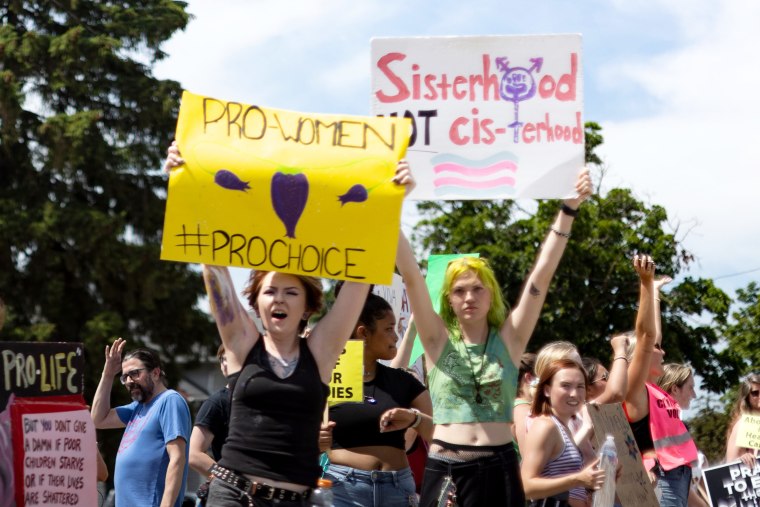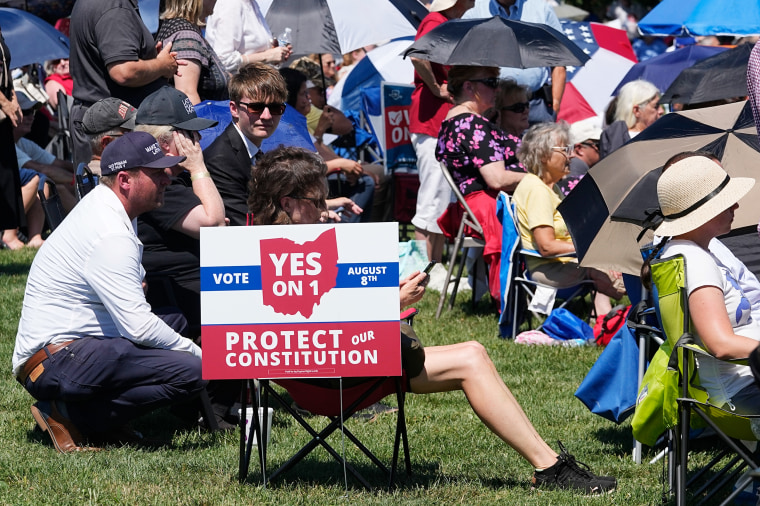In August, Ohio voters overwhelmingly rejected Issue 1, a Republican-backed ballot measure that would have made it harder to protect abortion rights.
In November, Issue 1 will be on the ballot again. But this time, voting for the ballot measure would enshrine abortion rights in the state constitution.
Confused?
Groups working to expand abortion rights in the state worry Ohio voters may be, too, and they are taking steps to ensure people know how to accurately and correctly cast their ballot on Nov. 7.
Ohioans United for Reproductive Rights, a coalition of groups supporting abortion rights, has ramped up door-knocking and phone-banking.
“We’re making sure voters understand,” Gabriel Mann, a spokesperson for the group, told NBC News. “Not just what’s at stake, but exactly how to protect what’s at stake.”
The Issue 1 on the ballot in August asked voters to decide on several measures that would have made it difficult to pass state constitutional amendments, including, most prominently, whether to raise the threshold of support required for future amendments to pass to 60% from the majority currently needed.
Reproductive rights groups portrayed the issue as another referendum on abortion rights, urging voters to vote “no” and explaining that raising the threshold would have made it more difficult for the proposed amendment on the ballot in November to pass. Anti-abortion groups, meanwhile, pushed voters to cast “yes,” with many Republican officeholders, including Republican Secretary of State Frank LaRose — who is also a Senate candidate — openly acknowledging that the purpose of the measure was to help prevent the November abortion-rights proposal from passing.
Last month, however, when LaRose’s office — which oversees all matters related to ballot language and labeling ballot measures — announced details about the November ballot, it labeled the proposed amendment that would enshrine abortion rights in the state constitution as Issue 1.
As a result, abortion-rights groups that spent all that time educating voters to say "no" to Issue 1 will now have to make sure their voters pick "yes" on Issue 1 in November. Anti-abortion groups will have the same challenge in reverse.
While in theory, the scenario would be likely to equally disadvantage both sides, abortion-rights groups are refusing to take any chances.
Anti-abortion groups, on the other hand, say they’re not worried. Amy Natoce, a spokesperson for Protect Women Ohio, the largest group in the state working to prevent the expansion abortion rights, said they are “not concerned about voter confusion surrounding the labeling of Issue 1” and instead are doubling down on a strategy to tie the matter to parental rights.
Abortion-rights groups find that nonchalance suspicious. They have accused LaRose, an abortion opponent, of putting his thumb on the scale by using the powers of his office to make it harder for pro-abortion-rights voters to figure out which way to vote.
“The fact that there are two Issue 1s, and our side is having to get people to vote ‘no’ in August and ‘yes’ in November — that is to create voter confusion,” Mann said.
“It’s 100% a tactic. It’s called Issue 1 because it was determined to be so by Frank LaRose, who actively campaigned against the issue in the August special election,” he added. “It’s not a coincidence.”
In May, LaRose said the August Issue 1 proposal was "100% about keeping a radical, pro-abortion amendment out of our constitution." But part of the fresh confusion appears to be a product of an unusual Ohio law rather than something specific by LaRose.
The law requires that the numbering of ballot measures start over with the number “one” after every election, even in races that occur in the same calendar year. As a result, a spokesperson for LaRose’s office said, the secretary of state was required to start anew with “Issue 1” for the measures appearing on the November ballot.
Pro-abortion-rights groups, however, claim the decision was strategic, alleging that a separate high-profile proposed constitutional amendment appearing on the ballot in November — one that would legalize the sale and use of recreational marijuana in the state — was intentionally labeled by LaRose’s office as Issue 2.
LaRose’s office pushed back against the accusation, explaining that the office labeled the issues, per state law, in the order they were fully certified.
“The ballot issue number was selected according to the order by which each petition was certified by the county boards of elections,” LaRose spokesperson Melanie Amato told NBC News. “The marijuana petitioners fell short of their initial certification requirement, so they had to use a cure period and gather more signatures. This resulted in a later certification process by the boards and our office.”
In many other states, ballot measure numbers start over each year or decade — a design that tends to prevent the Ohio scenario from playing out. (Ohio Republican legislators last month introduced a bill that would change the numbering method for ballot measures to avoid repeating this year’s debacle.)

The fresh tensions over the fight to expand abortion rights in the state are only the latest in a monthslong series of squabbles on the issue.
Last month, the state Supreme Court handed a victory to the state’s GOP-controlled Ballot Board — which is overseen by LaRose’s office — ruling that the words “unborn child” can remain in the language of the November ballot measure. Abortion-rights groups had claimed that the Ballot Board’s decision to use that particular language was designed to mislead voters.
The proposed November amendment is designed to counteract Ohio’s “heartbeat bill,” which snapped into place immediately after the Supreme Court overturned Roe v. Wade last year. The law effectively bans most abortions — with exceptions for the health of the pregnant woman and in cases of ectopic pregnancies — but remains temporarily blocked by a state judge. The case is now before the state Supreme Court, which heard oral arguments last week. It remains possible, due to the narrow way in which the case was argued by the state, that the court could allow the ban to take effect ahead of the November vote, while not weighing in on whether the law is constitutional.
While the August measure was resoundingly defeated — marking another clear win for reproductive rights advocates — Mann’s group said it would not fall into the trap of feeling overconfident about the November election.
“We know that voters are on our side, but we’re not at all taking it for granted that we can win,” he said. “We’re making sure to keep pushing as hard as we possibly can on voter turnout.”

